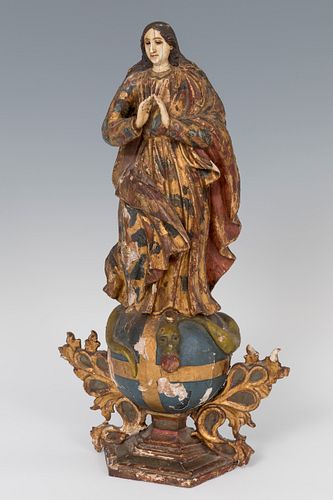Mexican school; XIX century. "Purisima". Polychrome wood carving and elephant ivory.
Lot 6
About Seller
Setdart Auction House
Carrer Aragó 346
Barcelona
Spain
Setdart Subastas was born in 2004 and is currently the first online art auction in Spain with solidity, prestige and reliability guaranteed by our more than 60,000 users. Setdart has a young, dynamic and enterprising team ready to successfully manage the purchase and sale of art works through custom...Read more
Estimate:
EUR€3,000 - EUR€4,000
$3,125 - $4,166.67
Absentee vs Live bid
Two ways to bid:
- Leave a max absentee bid and the platform will bid on your behalf up to your maximum bid during the live auction.
- Bid live during the auction and your bids will be submitted real-time to the auctioneer.
Bid Increments
| Price | Bid Increment |
|---|---|
| EUR€0 | EUR€10 |
| EUR€200 | EUR€25 |
| EUR€500 | EUR€50 |
| EUR€1,000 | EUR€100 |
| EUR€3,000 | EUR€200 |
| EUR€5,000 | EUR€500 |
| EUR€10,000 | EUR€1,000 |
| EUR€20,000 | EUR€2,000 |
| EUR€50,000 | EUR€5,000 |
About Auction
By Setdart Auction House
Oct 20, 2021
Set Reminder
2021-10-20 07:30:00
2021-10-20 07:30:00
America/New_York
Bidsquare
Bidsquare : OLD MASTERS
https://www.bidsquare.com/auctions/setdart-auction-house/old-masters-7700
Setdart Auction House sofia@setdart.com
Setdart Auction House sofia@setdart.com
- Lot Description
Mexican school; XIX century. "Purisima". Polychrome wood carving and elephant ivory. Damaged. Attached certificate issued by the Spanish Federation of Antique Dealers. Measures: 43 x 24 x 16 cm. Round sculpture in carved and polychrome wood and ivory, representing the Virgin as Purisima, full body, on a pedestal formed by a large blue orb, on which is arranged the snake with the apple in the mouth, representing sin. The Virgin appears dressed in tunic and mantle, although the decoration of both gives rise to visually merge with each other. Arranged with her hands joined in prayer at chest level and her face slightly tilted to one side. It is an image still anchored in the Mannerist heritage because of its balanced position, as well as its closed composition, but it also shows a great influence of the Baroque carvings, which is reflected in the folds of the canvases, wide and very chiaroscuro, worked with a lot of relief. In addition, the sculptor has taken special care to reflect the expression of serene and mystical happiness of Mary's face, magnificently achieved. Medieval Christianity passionately debated the belief that Mary had been conceived without the stain of original sin. Some universities and corporations swore to defend this privilege of the Mother of God, several centuries before the First Vatican Council defined the dogma of faith in 1854. At the end of the Middle Ages the need to give iconographic form to this idea was born, and the model of the Apocalyptic Woman of St. John was taken, maintaining some elements and modifying others (the Apocalyptic Woman is pregnant, but not the Immaculate). The definitive image came to fruition in the 16th century. Following a Valencian tradition, the Jesuit Father Alberro had a vision of the Immaculate Conception and described it to the painter Juan de Juanes so that he could capture it as faithfully as possible. It is an evolved iconographic concept, sometimes associated with the theme of the Coronation of the Virgin. Mary appears standing, dressed in a white tunic and blue mantle, her hands crossed on her chest, with the moon at her feet (in memory of Diana's chastity) and stepping on the infernal serpent (symbol of her victory over Original Sin). Around his head, like a halo, he wears the twelve stars, symbol of fullness and allusive to the twelve tribes of Israel. Most of these images are accompanied, in art, by the Marian symbols of the litanies and psalms, such as the mystical rose, the palm tree, the cypress, the enclosed garden, the ark of Faith, the gate of Heaven, the ivory tower, the sun and the moon, the sealed fountain, the cedar of Lebanon, the spotless mirror, the morning star, etc.
- Shipping Info
-
In-house shipping available. Please inquire at admin@setdart.com.
-
- Buyer's Premium



 EUR
EUR CAD
CAD AUD
AUD GBP
GBP MXN
MXN HKD
HKD CNY
CNY MYR
MYR SEK
SEK SGD
SGD CHF
CHF THB
THB










